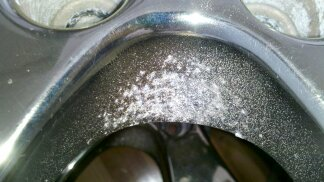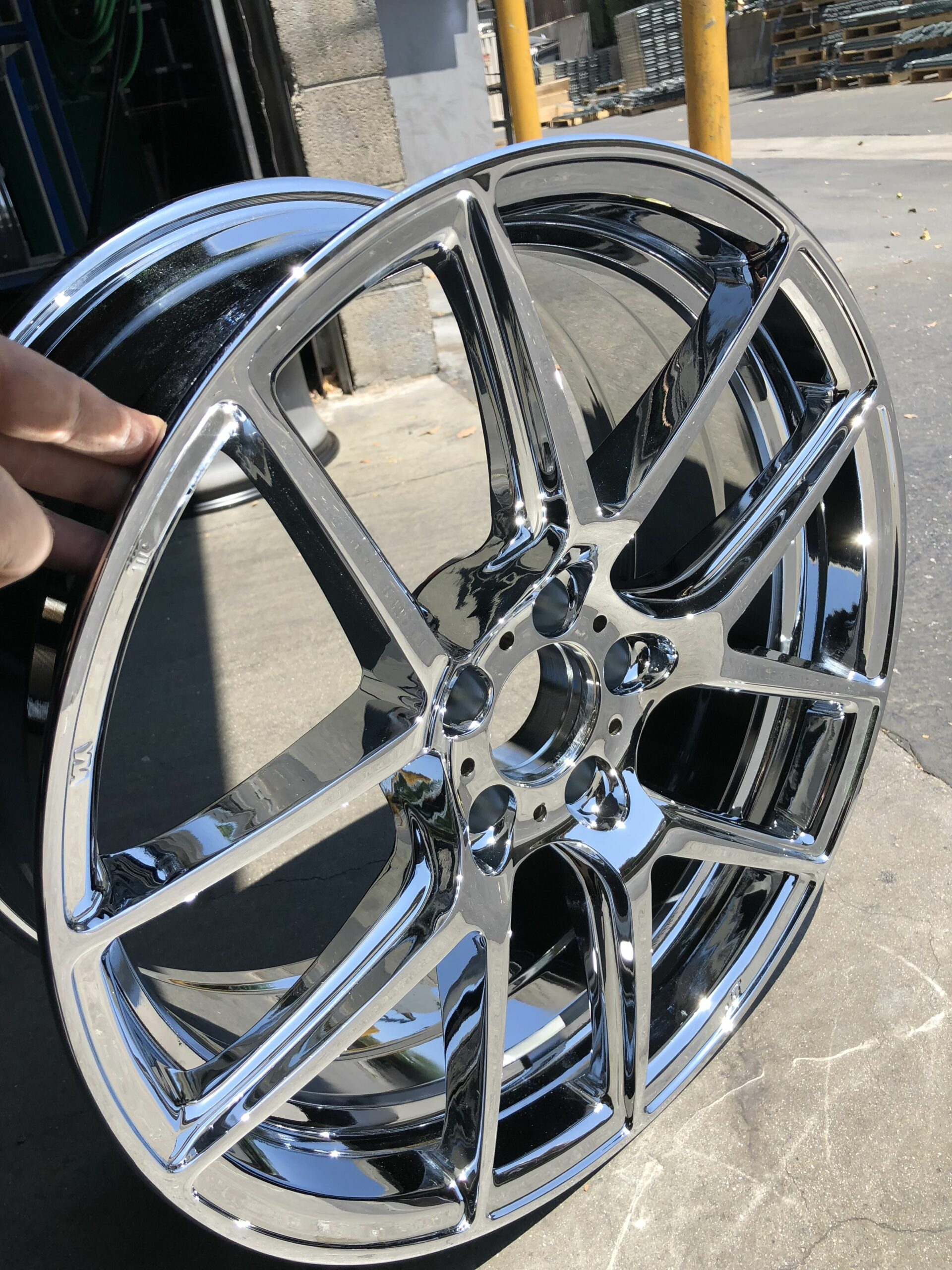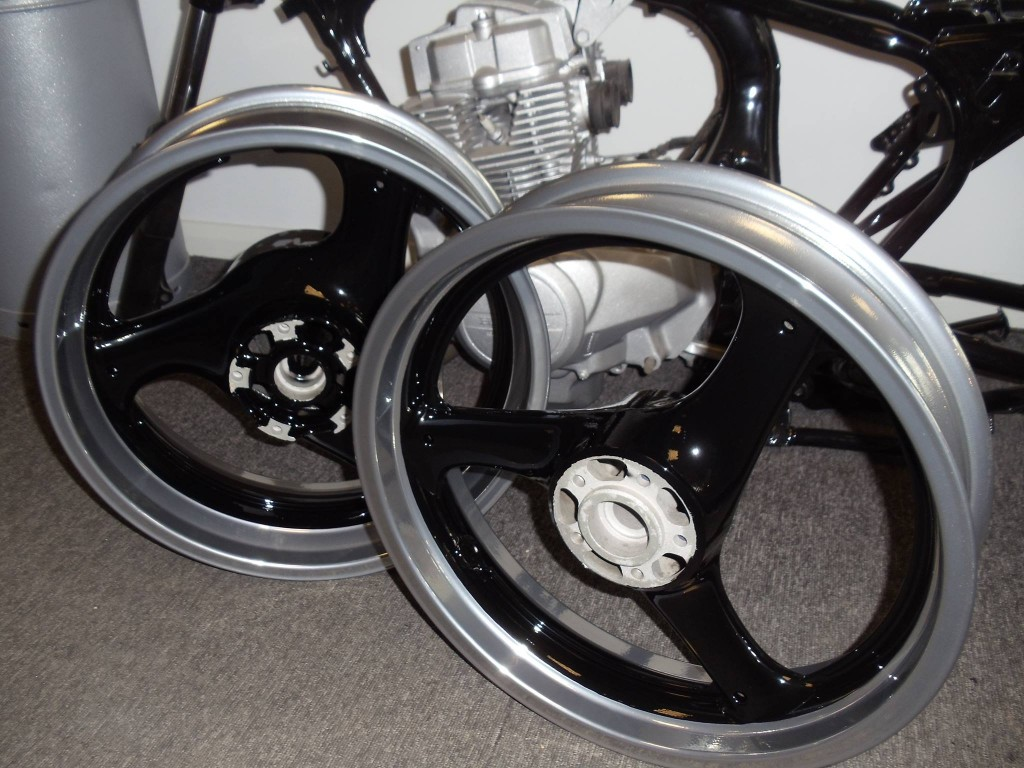Chrome Powder Coating: Benefits and Applications

Discover how chrome powder coating delivers a mirror-like finish with superior durability, eco-friendliness, and versatility for auto and industrial parts.
Introduction
Chrome powder coating is a modern surface finishing method used to improve the look and durability of metal parts. It works by spraying charged powder onto a metal surface and curing it at high temperature. The result is a smooth, shiny finish that closely resembles traditional chrome plating.
This process is becoming popular across industries such as automotive, home appliances, and decorative hardware. Compared with chrome plating, it offers several clear benefits:
● More environmentally friendly and chemical-free
● Lower production and maintenance costs
● Strong corrosion and wear resistance
In recent years, new variations like black and gold chrome finishes have gained attention. The chrome powder coat process allows manufacturers to produce different metallic tones and effects, giving designers more options for creative and high-end product finishes.
What Is Chrome Powder Coating?
Definition and Working Principle
Chrome powder coating is a dry finishing technique that gives metal parts a shiny, chrome-like surface. The process works by spraying electrically charged powder onto a grounded metal object. During heating, the powder melts and bonds to the surface, forming a smooth and durable layer.
This method avoids liquid solvents and toxic chemicals used in traditional chrome plating. It provides even coverage, strong adhesion, and a brilliant metallic appearance suitable for complex shapes such as automotive wheels, handles, and decorative components.
Main steps include:
● Cleaning and preparing the metal surface
● Electrostatic powder application
● High-temperature curing to form a dense coating
● Optional clear coating for added gloss and protection
Types of Chrome Finishes and Visual Differences
Different types of chrome powder coatings produce various visual effects. Each offers a unique tone and reflection level suitable for different design needs.
Type | Appearance | Description |
|---|---|---|
Standard Chrome | Bright silver mirror | Provides a classic chrome look with a reflective metallic finish. |
Black Chrome Powder Coat | Deep gray to black gloss | Offers a modern, bold aesthetic often used for luxury wheels and accessories. |
Gold Chrome Powder Coat | Rich golden metallic shine | Creates a premium and elegant finish for decorative or high-end products. |
For ultra-bright or mirror finishes, an additional clear topcoat is often applied. The transparent layer helps preserve gloss, prevent oxidation, and improve UV resistance — a common practice recommended by many coating manufacturers.
Advantages and Limitations of Chrome Powder Coating
Key Advantages of Chrome Powder Coating
Chrome powder coating is widely recognized for its strong protection and attractive metallic look. It offers both functional and environmental benefits, making it one of the best alternatives to traditional chrome plating.
Main advantages include:
● Durability: Excellent resistance to corrosion, UV rays, and surface impacts.
● Consistency: Smooth, even coating on flat and complex parts.
● Eco-friendly process: No harmful chemicals or heavy metals, and very low VOC emissions.
● Material versatility: Works well on steel, aluminum, and other metal substrates.
● Low maintenance: Long-lasting shine that requires minimal cleaning effort.
Limitations of Chrome Powder Coating
While chrome powder coating offers a visually striking metallic finish, it does have several limitations to consider:
Not a true mirror chrome — the finish is reflective but cannot fully match the mirror-like clarity of traditional electroplated chrome.
Color inconsistency risk — gloss and tone can vary depending on curing temperature, powder thickness, and batch formulation.
Sensitive to application conditions — overly thick application may dull the finish, especially on gold chrome powder coat; excessive heat can darken black chrome powder coat.
Limited chemical resistance — less resistant to harsh solvents and acids compared to high-end PVD or electroplated coatings.
Requires controlled curing environment — temperature fluctuations can cause yellowing, discoloration, or surface waviness.
Chrome Powder Coating vs. Traditional Chrome Plating
While both methods aim to produce a reflective metallic finish, their technical and environmental characteristics differ significantly.
Feature | Chrome Powder Coating | Traditional Chrome Plating |
|---|---|---|
Appearance | Bright metallic surface, mirror-like gloss | True mirror chrome, slightly higher reflectivity |
Durability | High resistance to corrosion and UV exposure | Can peel or crack over time |
Environmental Impact | Non-toxic, low-VOC, recyclable powder | Uses hazardous chemicals like hexavalent chromium |
Cost Efficiency | Lower operational and maintenance cost | Higher cost due to chemical waste treatment |
Maintenance | Easy to clean or recoat when damaged | Complex, requires re-plating |
Applications | Automotive, home appliances, outdoor parts | Jewelry, show pieces, limited decorative use |
In summary, chrome powder coating provides a cost-effective, durable, and sustainable solution for modern metal finishing needs. It’s especially ideal for manufacturers looking to replace electroplating with a safer and more efficient process.
Want to know which coating fits your product best? Contact Unionfab for expert recommendations and material testing support.
Chrome Powder Coating Process Overview
The chrome powder coating process involves several precise steps that determine the quality, adhesion, and final appearance of the coating. Each stage requires strict control of surface preparation, application technique, and curing temperature to ensure a smooth, mirror-like finish.
1. Surface Preparation
Before coating begins, all metal surfaces must be completely clean. Any oil, dust, or rust will reduce adhesion and create surface defects.
● Common preparation methods include: Degreasing to remove oils and residues.
● Sandblasting or shot blasting to roughen the surface and enhance powder adhesion.
● Chemical pretreatment such as phosphate coating to improve corrosion resistance.
Proper surface treatment ensures the coating bonds evenly and prevents bubbling or peeling during curing.
2. Base Layer Application
A thin base layer is sometimes applied before the chrome layer to enhance color uniformity and improve reflectivity.
● This undercoat is often a silver or clear powder that stabilizes the final gloss.
● The surface must remain dust-free before the main powder is sprayed.
3. Main Chrome Powder Application
This is the core stage of the chrome powder coating process. The powder is electrostatically charged and sprayed onto the grounded part using a specialized spray gun.
● The voltage setting (usually 60–90 kV) ensures proper particle attraction.
● Powder thickness control (typically 60–100 μm) is crucial for even coverage and a consistent metallic shine.
● Temperature and humidity of the working environment directly affect powder flow and surface appearance.
Notes: In the chrome powder coating process, temperature and powder thickness are the key factors that determine the coating’s visual quality and smoothness.
4. Curing and Baking
After spraying, the coated parts are moved into an oven to melt and fuse the powder into a continuous film.
● Typical curing temperature: 160–200 °C (320–392 °F)
● Duration: 15–30 minutes, depending on part size and thickness
● Uniform heating is essential to avoid color variation or surface orange peel.
The part should remain at the target temperature long enough for full crosslinking, ensuring maximum hardness and durability.
5. Post-Treatment and Finishing
Once cooled, optional finishing steps can further enhance appearance and protection:
● Polishing to boost reflectivity and achieve a mirror effect.
● Clear sealing to protect against oxidation and UV fading.
● Quality inspection for film thickness, adhesion, and surface gloss.
Through precise control of every stage, chrome powder coating achieves a high-performance metallic surface that is both visually striking and long-lasting — ideal for automotive, industrial, and consumer applications.
Common Issues and Solutions in Chrome Powder Coating
Even with careful process control, challenges can occur during the chrome powder coating process. Understanding these problems and their solutions helps ensure a consistent, high-quality finish across every batch.
1. Coating Peeling or Bubbling
Symptoms: The coated surface shows bubbles, blisters, or peeling after curing.

Source: Maxima Forums
Causes: Incomplete cleaning or residual oil and moisture on the surface; incorrect curing temperature or insufficient baking time; excessive powder thickness leading to trapped air or poor adhesion.
Solutions: Ensure thorough degreasing and drying before coating; verify oven temperature accuracy and part dwell time; apply the powder evenly and avoid over-spraying thick layers.
2. Uneven Mirror Finish
Symptoms: The coating appears dull, cloudy, or has inconsistent reflection across the surface.
Causes: Irregular powder application or poor grounding; overheating or under-curing during baking; excessive film thickness distorting reflectivity.
Solutions: Maintain consistent spray distance and voltage during electrostatic application; regularly check grounding and booth cleanliness; control coating thickness to maintain uniform reflection and gloss.
3. Temperature Control Issues
In the chrome powder coating process, temperature is one of the most critical parameters. If the curing oven temperature fluctuates or exceeds specifications, the coating may lose gloss or develop orange peel, while insufficient heat can result in weak adhesion and reduced durability.
Solution: Always calibrate the curing oven and confirm that the part surface temperature, not just air temperature, reaches the required range (typically 180–200 °C).
4. Color Tone Problems (Black and Gold Chrome)
Color accuracy and brightness can vary depending on powder formulation and process control.
● In black chrome powder coat, if the temperature is unstable or too high, the surface may appear darker or uneven. Maintaining a steady curing temperature ensures consistent deep metallic gloss.
● The gold chrome powder coat requires precise powder thickness control to retain brightness. If applied too thickly, the surface may become dull or yellowish.
Solution: Regularly monitor both application thickness and curing curve, and use test panels to fine-tune oven settings for each color type before full production.
By maintaining clean surfaces, accurate thickness, and stable temperature control, most coating problems can be avoided. Continuous quality checks and process monitoring are essential to ensure the chrome powder coating achieves its signature mirror-like brilliance.
Applications and Use Cases of Chrome Powder Coating
Automotive and Customization
The automotive industry is one of the main sectors benefiting from chrome powder coating, valued for its combination of durability, protection, and premium appearance. This coating offers excellent corrosion resistance and a mirror-like metallic gloss that enhances both performance and design.
Typical applications include:
● Wheels and rims
● Door handles and trims
● Interior components and grilles
Chrome powder coat wheels are especially popular for their bright reflective surface that resembles traditional plating but with stronger resistance to wear and weather.

Source: thewheelshopinc.com
Meanwhile, black chrome powder coat rims create a sleek, bold style commonly used in luxury or performance vehicles, blending sophistication with durability.

Source: ctc-powder-coating
Both finishes provide long-lasting protection from road salt, UV exposure, and impact damage, making them ideal for customized cars and motorcycles.
Home Appliances and Decorative Hardware
Chrome powder coating is also widely used in consumer and home applications. Its sleek metallic surface gives a premium look while maintaining excellent resistance to fingerprints, humidity, and cleaning agents.
Typical uses include:
● Kitchen appliances and metal panels
● Bathroom fittings and fixtures
● Furniture hardware, locks, and handles
The coating’s ability to combine aesthetic appeal with corrosion resistance makes it ideal for products that must look elegant and endure daily wear.
Industrial and Sports Equipment
In industrial and sporting goods manufacturing, chrome powder coating provides both protection and design value. It’s often applied to:
● Motorcycle frames and accessories
● Gym equipment and machine parts
● Precision-machined components requiring a metallic finish
These products benefit from enhanced surface strength, long-term gloss retention, and protection against moisture, oil, and abrasion. Whether for performance or visual effect, chrome powder coating ensures a durable and stylish surface that lasts.
Want to enhance your product’s look and durability? Get a 10% discount on your first chrome powder coating order with Unionfab.
How to Choose Chrome Powder Coating Materials and Suppliers
Material Quality and Brand Selection
At Unionfab, we understand that the success of any chrome powder coating project begins with the right material. High-performance powders ensure strong adhesion, smooth coverage, and a brilliant metallic reflection close to mirror chrome.
Our engineers carefully select coating materials based on:
● Adhesion and durability – to prevent cracking or peeling even on complex shapes.
● Reflectivity and gloss level – to achieve consistent high-shine finishes.
● Curing stability – ensuring accurate color and long-term resistance to oxidation.
● Cross-material compatibility – suitable for aluminum, steel, and alloy parts.
Whether you need a classic chrome finish or a black chrome powder coat for modern automotive applications, Unionfab provides reliable material sourcing and verified performance data from trusted global suppliers.
Evaluating the Right Supplier
Choosing a coating supplier is not only about price — it’s about precision, consistency, and trust.
At Unionfab, we combine advanced manufacturing technology with strict quality control to deliver coatings that meet international standards.
Why choose Unionfab:
● Proven experience — trusted by over 30,000 engineers, designers, and manufacturers worldwide.
● Integrated services — from design, machining, and chrome powder coating to surface finishing — all under one roof.
● Certified quality — ISO 9001 and RoHS-compliant processes ensure both safety and reliability.
● Transparent quoting — our instant quoting system lets you select materials and finishes with real-time cost feedback.
This full-chain approach reduces coordination time and ensures every part maintains consistent gloss, color, and surface strength.
Balancing Cost and Performance
Different powder coatings offer different combinations of appearance, lifespan, and price. Unionfab helps you find the right balance for your production needs.
Finish Type | Cost Level | Expected Lifespan | Typical Application |
|---|---|---|---|
Standard Chrome | ★★☆☆☆ | 5–7 years | Decorative trim, interior parts |
Black Chrome Powder Coat | ★★★☆☆ | 7–10 years | Automotive rims, high-end hardware |
Gold Chrome Powder Coat | ★★★★☆ | 8–10 years | Luxury décor, appliances, premium metal parts |
When evaluating cost, Unionfab considers total lifecycle value — not just price per kilogram. A well-formulated coating can extend service life, reduce rework rates, and enhance product appearance, leading to real savings over time.
At Unionfab, our experts are ready to help you select the best chrome powder coating solution for your next project. Request a free cost evaluation or technical consultation to find your perfect balance of performance and aesthetics.
Maintenance and Care After Chrome Powder Coating
Proper maintenance keeps chrome powder coating surfaces bright, durable, and corrosion-resistant over time. Although the coating is highly protective, following a few key care steps helps maintain its mirror-like finish for years.
1. Cleaning Guidelines
Regular cleaning removes dirt, oil, and water spots that can dull the surface.
Do:
● Use mild, neutral detergents and soft microfiber cloths.
● Rinse with clean water and dry thoroughly to avoid streaks.
Avoid:
● Strong acids or alkalis.
● Abrasive pads or harsh chemicals that may scratch the coating.
2. Regular Inspection Checklist
Inspect your coated parts periodically for early signs of wear:
Issue | Possible Cause | Action |
|---|---|---|
Scratches or abrasions | Friction or impact | Polish lightly or apply touch-up coating |
Peeling or flaking | Poor adhesion or corrosion | Strip and recoat the affected area |
Fading or discoloration | UV or salt exposure | Clean regularly and apply protective wax |
Water stains | Improper drying | Rinse and dry immediately after washing |
3. Repair and Maintenance Tips
● Minor scratches: Use touch-up powder or light re-spraying for localized repair.
● Severe damage: Full recoating may be required to restore adhesion and gloss.
● Environmental protection: For outdoor or coastal environments, schedule cleaning every 2–4 weeks to prevent salt buildup.
4. Longevity Tips for Chrome Powder Coating
To maximize coating life and maintain high reflectivity:
● Avoid direct metal-to-metal contact or hard impacts.
● Clean off contaminants such as oil, salt, and dust promptly.
● Store coated parts away from chemical vapors and high humidity.
With proper care, chrome powder coating can retain its brilliance for over 10 years, even in demanding conditions.
FAQs
Q1: Can you powder coat over chrome?
Yes, but not directly. Before applying a new layer, the chrome surface must be sandblasted or chemically etched to create texture for adhesion. Without proper surface preparation, the new coating may peel or bubble. At Unionfab, we use advanced pre-treatment methods to ensure strong bonding and long-term durability.
Q2: Can you powder coat chrome rims or chrome wheels?
Absolutely. Chrome powder coat wheels and chrome rims are among the most popular automotive uses. The process improves corrosion resistance and creates a high-gloss or black chrome look. It’s a durable and eco-friendly alternative to traditional plating for car enthusiasts and manufacturers.
Q3: How long does powder coating last?
When properly applied and maintained, chrome powder coating typically lasts 7–10 years or more. Its durability depends on surface preparation, curing temperature, and environmental exposure. Regular cleaning and inspection help preserve gloss and extend lifespan.
Q4: How to remove powder coat from metal parts?
Powder coating can be removed by chemical stripping, abrasive blasting, or controlled thermal stripping. The best method depends on the base metal and coating type. Unionfab offers professional recoating services to safely restore or refinish your parts.
Q5: Can you powder coat exhaust parts?
Yes, but only with high-temperature resistant powder coatings. Standard chrome powder coating cannot handle extreme heat, while specialized heat-resistant coatings used by Unionfab can perform well on exhaust systems and engine components.

